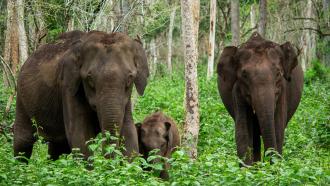![An Asian elephant calf placing grass on the right side of its mouth [Image credits: T. Revathe] Right or Left: Elephant calves pick their ‘trunk handedness’ early on in life](/sites/researchmatters/files/styles/large_800w_scale/public/elephant_20jul.png?itok=lisea7__)
An Asian elephant calf placing grass on the right side of its mouth [Image credits: T. Revathe]
Viral videos of elephant calves frolicking with their antics are sure to bring a smile or a hearty laugh. It is hard to miss seeing how ineptly they use their short little trunks while eating, playing or bothering their mommies. Just like how we are either 'left-handed' or 'right-handed', based on which hand we often use, elephants also have a preference in using their trunk either to the left or the right side. A new study by researchers at the Jawaharlal Nehru Centre for Advanced Scientific Research (JNCASR) investigates how and when calves learn to use their trunks.
Elephant calves are born precocial—they are at an advanced stage where they can see, stand up, and feed on their own almost immediately after birth. Though they depend on their mothers for nutrition for the first two years of their lives, calves move independently very early in life. However, control over their trunks, which play a vital role in feeding and social interactions, develops slowly.
"Asian elephant calves have a prolonged period of nutritional and social dependency on the mother," explains T. Revathe, who studies elephant behaviour. "This dependency can lead to the emergence of interesting social interactions," adds Prof TNC Vidya, who’s group at JNCASR works on understanding the behaviour and social organisation of Asian elephants.
The current study explores the trunk-handedness and behavioural development of Asian elephant calves in the Nagarhole and Bandipur National Parks in Karnataka. The findings have been published in the International Journal of Developmental Biology.
Elephants are the only surviving members of the family of trunked animals. Trunk usage was thought to develop gradually. However, previous observation on a calf found that preference in using the side of the trunk, also known as trunk-handedness, developed very early in life. In the current study, the researchers investigated whether trunk-handedness arose before adept trunk use. They looked at videos of 30 calves from eleven elephant clans.
The researchers looked at the direction (clockwise or anticlockwise) in which calves rotated the trunk to pluck, gather or pull vegetation and which side of the mouth they placed their food. They also noted how the trunks touched the ground and which side of their body they touched the most. All these observations gave a sense of their trunk-handedness.
The study showed that calves develop trunk-handedness within three months of age. The preferences for one side for feeding increased with age as they developed better motor control of the trunk. Interestingly, trunk-handedness was not dependent on how successfully they used their trunk, hinting that it might be an innate characteristic.
The researchers also examined at what time of their growing phase the calves show adult-like behaviours. They classified calf behaviours, exhibited during their interaction with the adults, into four categories—feeding, grooming, resting, and play-related behaviours. They also categorise 81 behavioural actions as preparatory-calf, calf-specific, preparatory-adult, and adult-like behaviours.
"Preparatory-calf behaviours are those that are shown only by calves but are not yet fully developed. On the contrary, preparatory-adult behaviours are shown by adults but are not yet completely developed in calves. They are still being learnt, practised, and elaborated," explains Revathe.
For example, newborn calves have to learn to differentiate between the forelegs and hindlegs of the mother. Trying to orient themselves properly to obtain milk from the mother is preparatory-calf behaviour. Older calves pulling out grass from an area where an adult has fed and learning to locate feeding spots show preparatory-adult behaviours.
The study found that as calves grew up, they spent less time resting and more time feeding. Until they were two years old, the time spent on feeding increased, and then was stable. Resting-related, certain grooming-related, and many social behaviours were shown by calves in adult-like form from a young age, whereas feeding-related behaviours that required trunk use developed more gradually over 6 months to 1 year of age.
Calves and adults need to synchronise some behaviours to maintain cohesion within the group. The study found that feeding was highly synchronised throughout the development of the calves. In contrast, resting behaviour synchrony increased as the calves aged as they spent most of their early months sleeping. Social interactions of the calves mirrored that of adults as the calves grew up. On the other hand, grooming-related activities became independent from adult grooming behaviour with increasing age.
The findings of the study show the vital aspects of a calf's development in Asian elephants. The researchers opine that understanding whether the early onset of trunk laterality is due to evolutionary bias can be obtained by studying the relatives of elephants and of other species with elongated noses such as tapirs.
"The work on behavioural milestones is basic data that are essential before other kinds of studies on Asian elephants are carried out. If one wanted to study a particular kind of behaviour, we now know at what stage elephants show adult-like behaviour and can choose subjects accordingly", concludes Dr Vidya.
This article has been run past the researchers, whose work is covered, to ensure accuracy.






